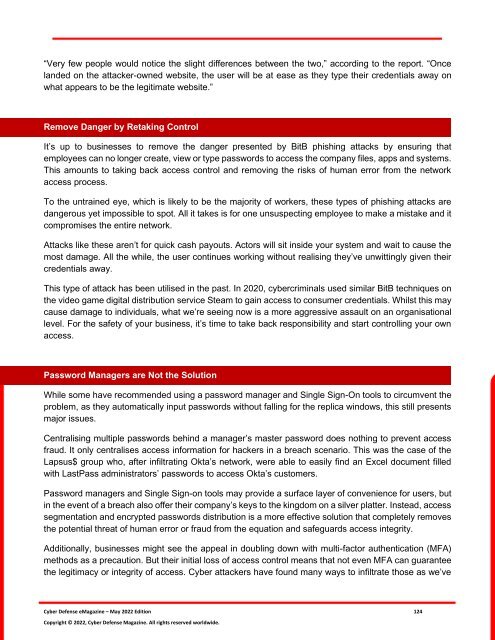Cyber Defense eMagazine May Edition for 2022
Cyber Defense eMagazine May Edition for 2022 #CDM #CYBERDEFENSEMAG @CyberDefenseMag by @Miliefsky a world-renowned cyber security expert and the Publisher of Cyber Defense Magazine as part of the Cyber Defense Media Group as well as Yan Ross, Editor-in-Chief and many more writers, partners and supporters who make this an awesome publication! Thank you all and to our readers! OSINT ROCKS! #CDM #CDMG #OSINT #CYBERSECURITY #INFOSEC #BEST #PRACTICES #TIPS #TECHNIQUES
Cyber Defense eMagazine May Edition for 2022 #CDM #CYBERDEFENSEMAG @CyberDefenseMag by @Miliefsky a world-renowned cyber security expert and the Publisher of Cyber Defense Magazine as part of the Cyber Defense Media Group as well as Yan Ross, Editor-in-Chief and many more writers, partners and supporters who make this an awesome publication! Thank you all and to our readers! OSINT ROCKS! #CDM #CDMG #OSINT #CYBERSECURITY #INFOSEC #BEST #PRACTICES #TIPS #TECHNIQUES
- No tags were found...
You also want an ePaper? Increase the reach of your titles
YUMPU automatically turns print PDFs into web optimized ePapers that Google loves.
“Very few people would notice the slight differences between the two,” according to the report. “Once<br />
landed on the attacker-owned website, the user will be at ease as they type their credentials away on<br />
what appears to be the legitimate website.”<br />
Remove Danger by Retaking Control<br />
It’s up to businesses to remove the danger presented by BitB phishing attacks by ensuring that<br />
employees can no longer create, view or type passwords to access the company files, apps and systems.<br />
This amounts to taking back access control and removing the risks of human error from the network<br />
access process.<br />
To the untrained eye, which is likely to be the majority of workers, these types of phishing attacks are<br />
dangerous yet impossible to spot. All it takes is <strong>for</strong> one unsuspecting employee to make a mistake and it<br />
compromises the entire network.<br />
Attacks like these aren’t <strong>for</strong> quick cash payouts. Actors will sit inside your system and wait to cause the<br />
most damage. All the while, the user continues working without realising they’ve unwittingly given their<br />
credentials away.<br />
This type of attack has been utilised in the past. In 2020, cybercriminals used similar BitB techniques on<br />
the video game digital distribution service Steam to gain access to consumer credentials. Whilst this may<br />
cause damage to individuals, what we’re seeing now is a more aggressive assault on an organisational<br />
level. For the safety of your business, it’s time to take back responsibility and start controlling your own<br />
access.<br />
Password Managers are Not the Solution<br />
While some have recommended using a password manager and Single Sign-On tools to circumvent the<br />
problem, as they automatically input passwords without falling <strong>for</strong> the replica windows, this still presents<br />
major issues.<br />
Centralising multiple passwords behind a manager’s master password does nothing to prevent access<br />
fraud. It only centralises access in<strong>for</strong>mation <strong>for</strong> hackers in a breach scenario. This was the case of the<br />
Lapsus$ group who, after infiltrating Okta’s network, were able to easily find an Excel document filled<br />
with LastPass administrators’ passwords to access Okta’s customers.<br />
Password managers and Single Sign-on tools may provide a surface layer of convenience <strong>for</strong> users, but<br />
in the event of a breach also offer their company’s keys to the kingdom on a silver platter. Instead, access<br />
segmentation and encrypted passwords distribution is a more effective solution that completely removes<br />
the potential threat of human error or fraud from the equation and safeguards access integrity.<br />
Additionally, businesses might see the appeal in doubling down with multi-factor authentication (MFA)<br />
methods as a precaution. But their initial loss of access control means that not even MFA can guarantee<br />
the legitimacy or integrity of access. <strong>Cyber</strong> attackers have found many ways to infiltrate those as we’ve<br />
<strong>Cyber</strong> <strong>Defense</strong> <strong>eMagazine</strong> – <strong>May</strong> <strong>2022</strong> <strong>Edition</strong> 124<br />
Copyright © <strong>2022</strong>, <strong>Cyber</strong> <strong>Defense</strong> Magazine. All rights reserved worldwide.


















